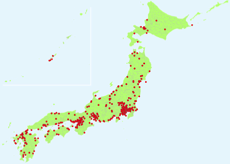Samples are selected in each installment using a stratified multi-stage sampling method.
-
12th and 13th Installments
Open or CloseFirstly, cities, wards, towns and villages were stratified into the six layers of: ward areas, cities with a population of 200,000 or greater, cities with a population of 100,000 or greater, cities with a population of less than 100,000, rural areas, and Okinawa prefecture. Next, 400 districts, streets, etc. were selected from each stratum with their probability of selection proportionate to their size. Lastly, the number of samples assigned to a location (an average of 16) were chosen through systematic sampling from the Basic Resident Register of that selected location.
400 Survey Locations for the 13th Installment
-
8th to 11th Installments
Open or CloseFirstly, cities, wards, towns and villages were stratified into the five layers of: ward areas, cities with a population of 200,000 or greater, cities with a population of less than 200,000, rural areas, and Okinawa prefecture. Next, 300 electoral districts were selected from each stratum with their probability of selection proportionate to size. Lastly, the number of samples assigned to a location (an average of 14 to 20) were chosen through systematic sampling from the Voter’s Registration List of that selected electoral district. -
3rd to 7th Installments
Open or CloseFirstly, cities, wards, town and villages were stratified into layers of 56 to 100 in consideration of their population size, regionality, and the industrial composition, among other factors. Next, a total of 180 to 303 cities, wards, towns and villages were sampled from each stratum, with their probability of selection proportionate to size. Additionally, electoral districts were selected within the sampled cities, wards, towns and villages, with their probability of selection also being proportionate to size. Lastly, the number of samples assigned to a location (an average of 18 to 20) were chosen through systematic sampling from the Voter’s Registration List of that selected electoral district. -
2nd Installment
Open or CloseFirstly, cities, wards, town and villages were stratified into 150 layers in consideration of their population size, regionality, and the industrial composition, among other factors. Next, a total of 24 electoral districts were sampled from each stratum as sampling points, with their probability of selection proportionate to size in wards. In the cities and rural areas, proportionate sampling was used to select cities, towns or villages, and 126 electoral districts were selected as the sampling points from among these selected units through probability proportionate sampling. Lastly, the number of samples assigned to a location were chosen through systematic sampling from the Voter’s Registration List of that selected electoral district. -
1st Installment
Open or CloseFirstly, cities, wards, town and villages were stratified into 150 layers in consideration of their population size, regionality, and the industrial composition, among other factors. Next, a total of 108 locations were selected through proportionate sampling from each stratum whereby a district or street within it was the sampling unit in wards. In the cities and rural areas, proportionate sampling was used to select cities, towns or villages, and 131 census districts were selected as the sampling points from among these selected units through proportionate sampling. Lastly, the number of samples assigned to a location were chosen through systematic sampling from the Basic Resident Register of that selected location.